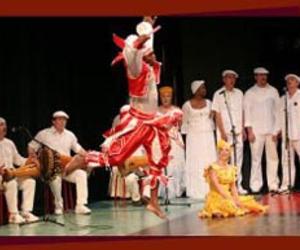Defining Cuban identity and Cuban Folklore Society
- Submitted by: manso
- Editorial Articles
- 12 / 14 / 2010

The African Diaspora and their descendants have been fully researched in Cuba, because its influence on folklore is such that it is associated with almost all the artistic and cultural expressions in the country.
By: Mildrey Ponce. The term folklore is associated with the whole set of traditions, beliefs, customs and popular knowledge of any culture that is transmitted generation to generation, mainly orally, which makes it the most direct way to know the idiosyncrasy of any nation.
It is found in their feeding habits, the way they dress, their dances, their traditional craftwork, their beliefs, their myths and their ways to celebrate.
In Cuba, beyond the academic sectors, the word folklore is associated with the artistic and cultural expressions of African origin, popular and poorly refined.
Indeed, the African Diaspora in Cuba and their descendants have been the targets of the largest number of studies in this branch of social sciences in the island.
Since early in the 20th century, this expression captivated many outstanding Cuban intellectuals, who contributed to the foundation of the Cuban Folklore Society.
Attempts to found a folklore society in Cuba materialized in 1923 under the auspices of the Economic Society of Friends of the Country.
Other institutions such as the University of Havana, the Association of Composers, the Association of Painters, the Catholic Church, the Academy of History and the Academy of Arts and Literature, also supported the foundation of Cuban Folklore Society
The young intellectual members of the avant-garde groups of the time became excited over the objectives of the recently created institution which favored research using hitherto unpublished or disregarded sources.
Some of its most relevant members included Cuban sage Don Fernando Ortiz, Jose Maria Chacon y Calvo and Carolina Poncet, the only recognized folklorists in the country, and historians Emilio Roig de Leuchsenring and Ramiro Guerra.
The Cuban Folklore Society emerged as a national multidisciplinary project. Its members hoped to create networks, which would gradually extend to branches in cities and towns across the island.
Its members and supporters focused mainly in the rescue of the heritage of African roots in Cuba, a trend that had a direct influence on the cultural field.
Some writers linked to the institution began to pay attention to the social status of the Blacks, their religious beliefs, their fantastic imagery or their musical preferences, as it is reflected in the novel Ecué yamba-ó by Alejo Carpentier.
Historians José Antonio Fernández de Castro and José Luciano Franco also worked in the compilation of literary works dealing with the Black issue.
Musicians that supported the Society such as Amadeo Roldán and Alejandro García Caturla composed pieces for symphonic orchestras and also for dances or dance shows and they were determined to internationalize Cuban music.
The new trends were not always well received. On November 29, 1925, something unusual happened at the National Theater when Roldán premiered his “Overture on Cuban Themes,” turning popular rhythms compiled from Black festivities into concert music.
Carpentier, a friend of Roldán and a supporter of his ideas, said:
“An authentic nationalist work in favor of arts can not be done unless people follow the path traced by Amadeo Roldán. His fresh Overture on Cuban Themes, regardless of who becomes upset, is a landmark in the history of Cuban music.”
Sculptors and painters such as Eduardo Abela and Jaime Valls also linked their work to the Black theme.
The efforts of the Cuban Folklore Society to save the legacy of the former slaves fueled a debate closely linked to the increase of racial discrimination as a political, social and cultural problem that attempted against the integrationist principles of the Cuban nation.
Article 11 of the Constitution of 1901 provided that all Cubans were equal before the law and that the Republic did not admit any privileges.
However, the racist mentality of the republican society was characterized by rejection of any kind of popular religious beliefs; this also included their music, dances, songs and literary expressions. Black was associated to barbarity, obscurantism, ignorance and social underdevelopment.
At the same time, the Black sector was a good research field because, according to figures of a census carried out in 1919, almost 3,000 Blacks born in Africa lived in Cuba.
The Cuban Folklore Society disappeared during the process of the 1930 Revolution against Gerardo Machado’s dictatorship, but it played a decisive role —along with the figure of Don Fernando Ortiz— in the direction of all similar projects to come.
In a time when the standards of public education were really low, this institution, in spite of its short life, fostered the development of a public awareness of the modernization of scientific and artistic knowledge.
In addition, it played a key role in the rescue and preservation of the Cuban popular culture, and contributed to improving cultural self-esteem, mainly among black people, through the validation of the popular heritage.
Translated by: Martha Lucía Martínez Casallas
Source:www.cubanow.net/pages/articulo.php?sec=38&t=2&item=8987
Comments